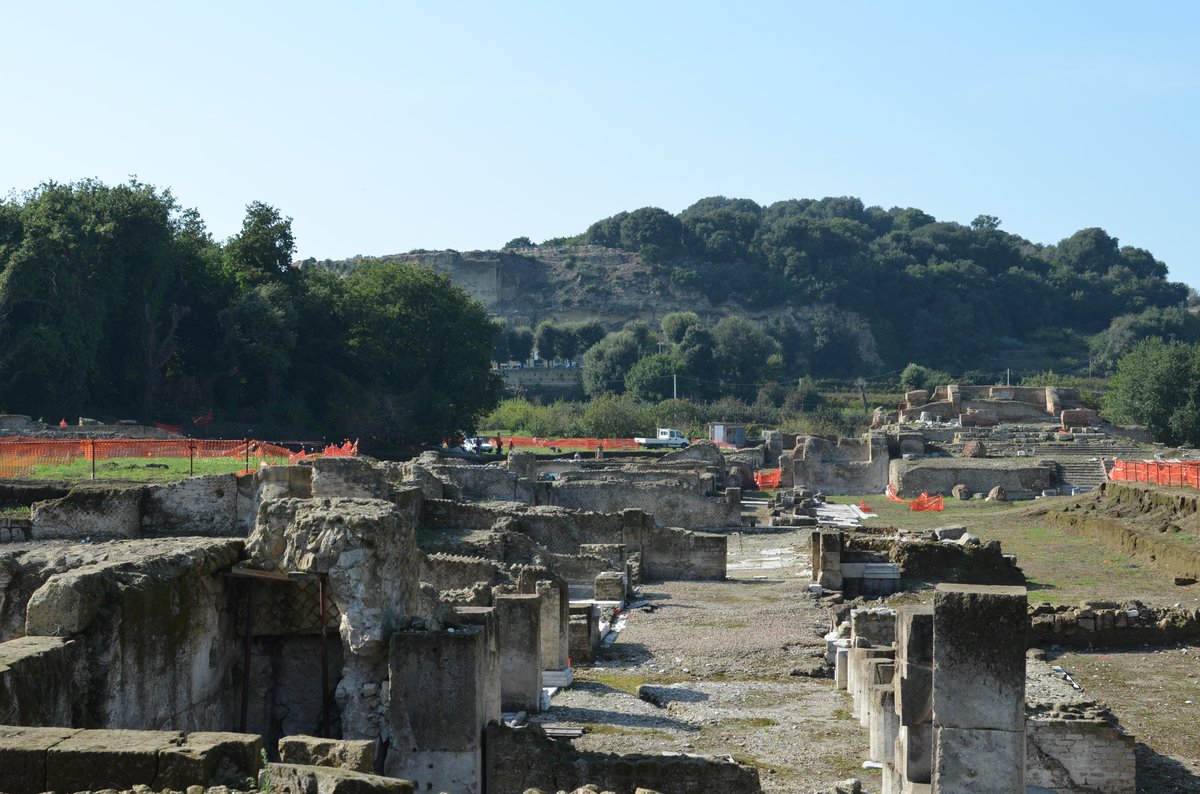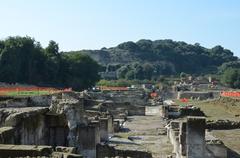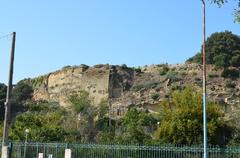
Acropolis of Cumae: Visiting Hours, Tickets, and Historical Sites Guide – Pozzuoli, Italy
Date: 14/06/2025
Introduction
Perched on a dramatic volcanic promontory overlooking the Tyrrhenian Sea and the Gulf of Pozzuoli, the Acropolis of Cumae is one of Italy’s most significant archaeological sites and the oldest Greek colony on the Italian mainland. Founded in the 8th century BCE by Greek settlers from Chalcis and Eretria, Cumae played a pivotal role in shaping the cultural and political landscape of Magna Graecia, introducing Greek urban planning, religious traditions, and the alphabet that influenced the Latin script. The site’s rich legacy threads together Greek mythology, Roman history, and enduring cultural heritage, making it an essential destination for history lovers and travelers exploring the Naples region (Summer in Italy; thebestnaples.eu; movery.it).
In this definitive guide, you’ll find everything needed to plan your visit, from historical context and site highlights to practical visitor information, accessibility details, and recommended nearby attractions.
Table of Contents
- Historical Background
- Main Archaeological and Artistic Highlights
- Visiting Information
- Practical Tips
- FAQs
- Conclusion
- References and Further Reading
Historical Background
Greek Origins and Settlement
Cumae was established around 750 BCE by Greeks from Euboea, notably the cities of Chalcis and Eretria (movery.it; italia.it). As the first Greek outpost on the Italian mainland, Cumae became a linchpin in the spread of Greek culture and urbanization throughout southern Italy (Magna Graecia). Archaeological evidence also suggests even earlier Iron Age settlements on the promontory, chosen for its commanding maritime position and fertile hinterland. The city soon established its own colonies, including Neapolis (Naples), Pozzuoli, Baiae, Miseno, and Capri.
Cultural Transmission and Mythology
Cumae was instrumental in transmitting the Greek alphabet to the Italic peoples, a process that led to the evolution of the Etruscan and later Latin scripts—cornerstones of Roman literature and Western civilization (thetravel.com). The city’s mythological significance is underscored by its famed oracle, the Cumaean Sibyl, whose cavern (Antro della Sibilla) was legendary throughout the ancient world. Virgil’s “Aeneid” immortalized this mystic figure, whose prophecies bridged Greek and Roman religious traditions.
Roman Conquest and Transformation
Cumae’s strategic and religious prominence made it a coveted prize. It was conquered by the Oscans in 421 BCE, later integrated into the Roman Republic in 338 BCE (Summer in Italy). Under Roman rule, the city’s architecture and urban fabric were reshaped, with temples, forums, and baths reflecting new civic and religious priorities. Cumae remained influential until its decline following Saracen raids in the 9th century and destruction in the early 13th century (movery.it).
Main Archaeological and Artistic Highlights
Temples and Sacred Spaces
The acropolis housed major temples dedicated to Apollo and Jupiter, symbolizing Cumae’s religious and political heart. The Temple of Apollo, among the oldest in mainland Italy, sits on the lower terrace, while the Temple of Jupiter crowns the summit—later repurposed as a basilica in Christian times. Visitors can explore the foundations, columns, and interpretive panels that reconstruct their ancient grandeur (thebestnaples.eu).
The Cumaean Sibyl’s Cave (Antro della Sibilla)
Perhaps the site’s most evocative feature is the trapezoidal tunnel carved into tufa rock, known as the Cave of the Sibyl. This 131-meter-long passage is steeped in myth, believed to be the very place where the prophetic Sibyl delivered oracles to ancient seekers and heroes like Aeneas. The atmospheric lighting and readings from classical texts enhance its mystical aura (movery.it; historyhit.com).
City Walls, Necropolis, and Urban Layout
The acropolis is encircled by 5th-century BCE fortification walls built from volcanic stone, later reinforced by Romans and Byzantines. The lower city showcases a grid-like street plan typical of Greek colonies, with remnants of markets, homes, and baths. Extensive necropoleis (cemeteries) illustrate funerary practices from the Samnite and Roman periods. Other highlights include the Roman amphitheater (seating up to 5,000) and the Via Sacra, the main ceremonial avenue (thebestnaples.eu).
Visiting Information
Opening Hours and Tickets
- April to October: 9:00 AM – 7:00 PM (last entry 6:00 PM)
- November to March: 9:00 AM – 4:00 PM
- Free Entry: On the first Sunday of each month via “Domenica al Museo”
- Ticket Prices (June 2025):
- Adults: €8
- Reduced (EU 18–25): €4
- Free: Children under 18, archaeology students, visitors with disabilities
Tickets can be purchased at the entrance or online at the CoopCulture portal. For current hours, always check the official Campi Flegrei Archaeological Park website.
Guided Tours and Visitor Services
Guided tours by licensed archaeologists or local experts are highly recommended and available in Italian and English (advance booking advised). Tours typically last 90–120 minutes and include the main monuments and myths. The site offers a bookshop, restroom facilities, vending machines for snacks and water, and informational panels in Italian and English.
Accessibility and Facilities
The site’s terrain is uneven, with stone steps and moderate inclines. While the lower acropolis and some main paths are accessible, visitors with mobility challenges may find certain areas difficult. Wheelchair access is limited—contact staff for advice. Parking is available near the entrance, and public transport connections are via train to Pozzuoli and local buses/taxis.
Getting There
- By Car: Follow signs from Pozzuoli or Naples; parking is available at the main entrance.
- By Public Transport: Take the train to Pozzuoli, then bus R4 or a taxi to Cumae. Walking from bus stops is required (thebestnaples.eu).
- Nearby Attractions: Combine your visit with sites such as the Flavian Amphitheater in Pozzuoli, Baia Archaeological Park, Solfatara Volcano, and Lake Avernus.
Practical Tips
- Best Time to Visit: Early morning or late afternoon, especially in spring or autumn, for pleasant weather and fewer crowds.
- What to Bring: Comfortable walking shoes, water, sun protection, a flashlight for the cave, and a camera.
- Safety: Stay on marked paths and supervise children, especially near caves and terraces.
- Photography: Non-flash photography permitted; tripods may require permission.
- Cultural Etiquette: Respect the ancient structures, avoid graffiti, and maintain quiet in sacred areas.
- Sustainability: Dispose of litter responsibly and follow site rules; drones are not permitted without authorization.
Frequently Asked Questions (FAQs)
Do I need a ticket to visit the Acropolis of Cumae?
Yes, unless visiting on the first Sunday of the month, when entry is free.
Is the site wheelchair accessible?
Only partially; some uneven paths and steps limit access. Check with staff for recommended routes.
Are guided tours available?
Yes, in Italian and English—book in advance for English tours.
Can I buy tickets online?
Yes, via the CoopCulture portal.
What other sites should I visit nearby?
Consider the Flavian Amphitheater, Baia Archaeological Park, Solfatara Volcano, and Lake Avernus.
Are there restaurants or cafés on-site?
No, but vending machines are available and towns nearby offer dining options.
Conclusion
The Acropolis of Cumae offers a unique window into the ancient Mediterranean world, where Greek and Roman legacies still resonate in its temples, caves, walls, and panoramic vistas. Its layered history—from the first Greek settlers to its role in the spread of the Latin alphabet and the enduring myths of the Sibyl—makes it a destination of both educational and inspirational value. Plan ahead by checking current opening hours and ticket options, wear sturdy shoes for the terrain, and consider a guided tour for deeper appreciation.
For the latest information and expert audio guides, download the Audiala app. Explore related sites in the Campi Flegrei region and follow us on social media for updates, travel inspiration, and event announcements.
References and Further Reading
- Visiting Cumae: History, Tickets, Hours, and Must-See Attractions Near Naples, 2025, Summer in Italy (Summer in Italy)
- Acropolis of Cumae: Visiting Hours, Tickets, History, and Must-See Naples Historical Site, 2025, movery.it & italia.it (movery.it)
- Main Attractions and Site Highlights, 2025, thebestnaples.eu (thebestnaples.eu)
- Visiting the Acropolis of Cumae: Hours, Tickets, and Exploring Campi Flegrei’s Historic Gem, 2025, parcoarcheologicocampiflegrei.it & CoopCulture (parcoarcheologicocampiflegrei.it), (CoopCulture)
Internal links to related articles:


